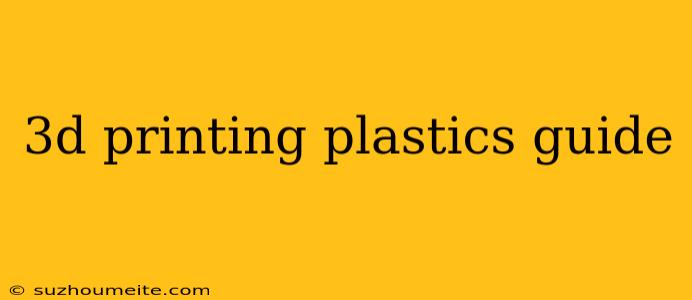3D Printing Plastics Guide
Introduction
3D printing has revolutionized the way we create objects, and plastics are one of the most popular materials used in this process. With the vast array of plastics available, it can be overwhelming to choose the right one for your project. In this guide, we will explore the most common types of 3D printing plastics, their properties, and applications.
Types of 3D Printing Plastics
1. PLA (Polylactic Acid)
- Properties: Biodegradable, renewable, and compostable.
- ** Advantages:** Easy to print, low warping, and minimal odor.
- Applications: Prototyping, models, and decorative items.
2. ABS (Acrylonitrile Butadiene Styrene)
- Properties: Strong, impact-resistant, and heat-resistant.
- Advantages: Good mechanical properties, can be glued and painted.
- Applications: Functional parts, mechanical components, and electronic casings.
3. PETG (Polyethylene Terephthalate Glycol)
- Properties: Strong, flexible, and resistant to chemicals.
- Advantages: Low warping, easy to print, and good layer adhesion.
- Applications: Prototyping, mechanical components, and functional parts.
4. Nylon
- Properties: Strong, flexible, and resistant to abrasion.
- Advantages: Good mechanical properties, low warping, and high impact resistance.
- Applications: Functional parts, mechanical components, and gear systems.
5. ASA (Acrylonitrile Styrene Acrylate)
- Properties: Strong, impact-resistant, and UV-resistant.
- Advantages: Good mechanical properties, low warping, and high heat resistance.
- Applications: Outdoor applications, automotive parts, and functional components.
6. PVA (Polyvinyl Alcohol)
- Properties: Water-soluble, biodegradable, and non-toxic.
- Advantages: Easy to print, low warping, and dissolves in water.
- Applications: Support material, sacrificial layers, and water-soluble parts.
7. TPU (Thermoplastic Polyurethane)
- Properties: Flexible, elastic, and abrasion-resistant.
- Advantages: Good mechanical properties, low warping, and high impact resistance.
- Applications: Flexible parts, rubber-like components, and phone cases.
Factors to Consider
When choosing a 3D printing plastic, consider the following factors:
- Printability: Ease of printing, warping, and layer adhesion.
- Mechanical Properties: Strength, flexibility, and impact resistance.
- Chemical Resistance: Resistance to chemicals, solvents, and moisture.
- Temperature Resistance: Heat resistance, melting point, and thermal stability.
- Cost: Price per kilogram, availability, and shipping costs.
Conclusion
With this guide, you're now equipped to choose the right 3D printing plastic for your project. Remember to consider the properties, advantages, and applications of each plastic to ensure a successful print. Happy printing!
